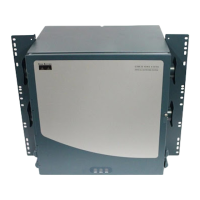13-17
Cisco ONS 15454 Procedure Guide, R5.0
December 2004
Chapter 13 Convert Network Configurations
NTP-A211 Convert a Two-Fiber BLSR to a Four-Fiber BLSR Automatically
NTP-A211 Convert a Two-Fiber BLSR to a Four-Fiber BLSR
Automatically
Note BLSR DRI configurations do not support in-service topology upgrades.
Note Two-fiber OC-48 or OC-192 BLSRs can be converted to four-fiber BLSRs. To convert, install two
additional OC-48 or OC-192 cards at each two-fiber BLSR node, then log into CTC and convert the
BLSR from two-fiber to four-fiber. The fibers that were divided into working and protect bandwidths for
the two-fiber BLSR are now fully allocated for working BLSR traffic. A span upgrade can be performed
before the two-fiber to four-fiber BLSR conversion.
Note BLSR protection channel access (PCA) circuits, if present, will remain in their existing STSs. Therefore,
they will be located on the working path of the four-fiber BLSR and will have full BLSR protection. To
route PCA circuits on protection channels in the four-fiber BLSR, delete and recreate the circuits after
the upgrade. For example, if you upgrade a two-fiber OC-48 BLSR to four-fiber, PCA circuits on the
protection STSs (STSs 25 to 48) in the two-fiber BLSR will remain in their existing STSs, which are
working STSs in the four-fiber BLSR. Deleting and recreating the OC-48 PCA circuits moves the
circuits to STSs 1 to 24 in the protect bandwidth of the four-fiber BLSR. To delete circuits, see the
“DLP-A333 Delete Circuits” task on page 20-21. To create circuits, see Chapter 6, “Create Circuits and
VT Tunnels.”
Note Before beginning this procedure, optical transmit and receive levels should be in their acceptable range
as shown in Table 2-3 on page 2-15.
Step 1 Complete the “DLP-A60 Log into CTC” task on page 17-66 at one of the two-fiber nodes that you want
to convert.
Step 2 Complete the “DLP-A298 Check the Network for Alarms and Conditions” task on page 19-63.
Step 3 Complete the “NTP-A16 Install the OC-N Cards” procedure on page 2-6 to install two OC-48 or OC-192
cards at each BLSR node. You must install the same OC-N card rate as the two-fiber BLSR.
Step 4 Connect the fiber to the new cards. Use the same east-west connection scheme that was used to create
the two-fiber connections. See the “NTP-A247 Install Fiber-Optic Cables on OC-N Cards” procedure on
page 2-14.
Purpose This procedure upgrades a two-fiber BLSR to a four-fiber BLSR without
disrupting traffic. The conversion will be easier if the same east and west
configuration is used on all nodes being upgraded.
Tools/Equipment None
Prerequisite Procedures NTP-A126 Create a BLSR, page 5-12
Required/As Needed As needed
Onsite/Remote Onsite
Security Level Provisioning or higher

